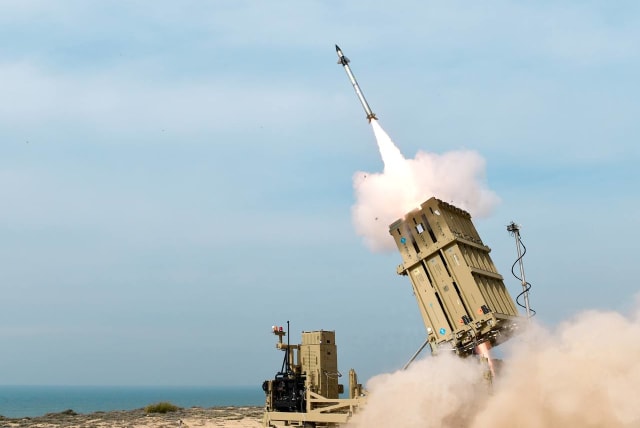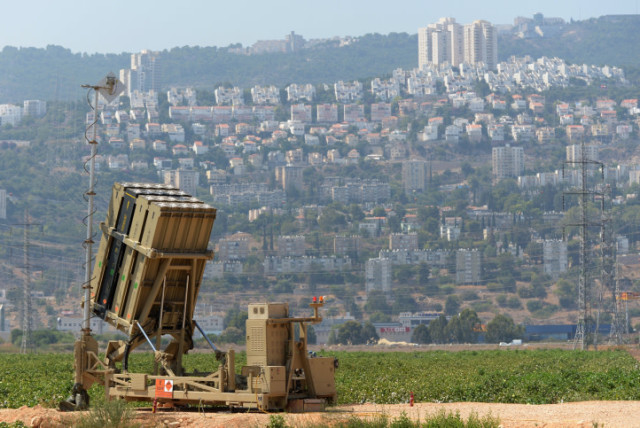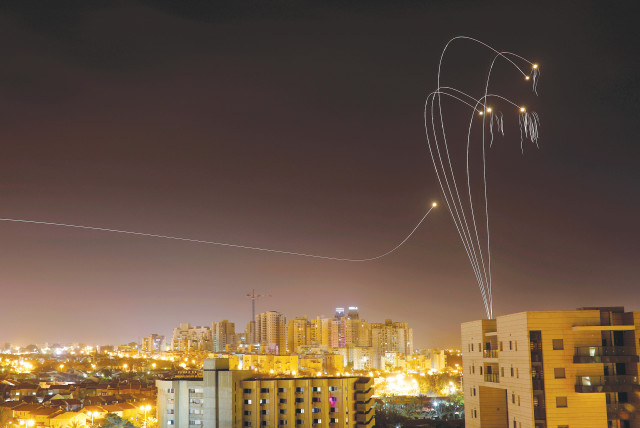From North to South, these Iron Dome teams allowed Israel to control the pace of war

IDF Lt.’s ‘O’ and ‘N’ tell Post of defensive units on Northern, Southern fronts
Despite the success of Israeli ground forces in Gaza, Jerusalem would not have had sufficient time to execute the invasion to this extent – if it weren’t for its Iron Dome forces protecting from Hamas and Hezbollah rocket threats.
On January 14, the IDF said that Hamas fired some 9,000 rockets into Israeli airspace from Gaza; 2,000 fell short. Hezbollah fired a combination of 2,000 rockets and anti-tank missiles into Israel from Lebanon and another 30 or so from Syria.
To understand what changed for the Iron Dome teams during a war that intensified in both the North and the South, The Jerusalem Post sat down with IDF Lt. ‘O’, responsible for the Haifa region, and Lt. ‘N’, responsible for the Gaza border.
The North
Lt. O, from Beit Hashmonai, spent all three years of his service in Iron Dome units, with at least one more year of service to go as part of the initial officer commitment, but says he may also continue on a longer officer track.
The IDF refrains from giving the exact locations of its batteries, which move around anyway, but O’s battery’s responsibility includes Haifa and nearby areas.
His Iron Dome sub-unit has around ten soldiers – and, since Oct. 7, significant additions of reservists. That sub-unit is part of a larger force of about 100, which includes guards, logistics, and everything else needed to run a unit.
He also managed the combat guards who defended Iron Dome batteries.
Both O and other officers said the Iron Dome shoot-down rate is around 90%. This does not mean that every incident activates the defense system. Each incident, he said, is analyzed on its own, and in some cases, it is unnecessary to use an interceptor on a rocket that wildly misfires from hitting anything but empty land.
Since Oct. 7, Hezbollah fired thousands of times on the North, at rates that far eclipse any prior small skirmishes at least since 2006. Questioned about the changes they have seen, O said that “the air defense battalions are always ready for any scenario. But many of us became more ready for challenges that we had not been as ready for.
“There is a certain balance of using force, responses, and counter-responses. We try to maintain the balance within a certain spectrum,” he said, adding that this includes the escalations experienced with Hezbollah recently in comparison to the earlier weeks.
He said the IDF remains on guard in case the conflict in the North balloons, adding that the military has been and continues to be more careful because Gaza is still unstable and remains the military’s main focus.
Hezbollah has evolved some of its tactics, including a few instances where it sometimes beat Israel’s missile defense system using anti-tank missiles flying at lower heights and with trajectories that are different from rockets, making them harder to shoot down.
In some cases over the last month, the terror group even achieved additional hits at IDF bases.
O said that different parts of the military are ready for any scenario and that “As the battle changes, we adapt to everything.”
However, he admitted, “There was an anti-tank missile a few weeks ago, which was a bit more problematic. But other systems can handle that. But the main threat are still rockets, and then drones.”
Hezbollah attacked Israel with far more drones during this war than the occasional one several months before the war.
“When you do something more times, you get better at it. We were capable pre-war against drones, but we have experienced a much higher pace” of drone attacks, he said.
So when do Hezbollah threats get shot down, and when are they allowed through to areas where they will not harm anyone? “As the officer in charge of the Iron Dome rotation, I make decisions based on many factors. I decide for the defense group and give them the approval to fire an interceptor against the target,” said O.
“It’s very defined. For every incident, you need to decide differently. In one incident, you will need to shoot down the threat. In another one, you let it go. You also need to be creative.”
IDF intelligence analysts from Lotem Unit have recently broken down some of Hamas’s rocket firing patterns, which were gathered using new digital data gathering tools, and helped them determine where the terrorist group most likely would need to place its rocket launchers to hit Israelis, such as occurred with a funeral procession on October 17.
That said, “There is often very little time, though sometimes there is more time, such as with an enemy drone sent to collect intelligence,” said O.
In one such case, “I spoke to a higher official and got permission from the official, and we shot it down.”
We are always ready, he said, “but still, when you have an event and it comes, the adrenaline also comes,” so you act quickly based on all of the training time you invested. “You know that people can live in quiet because of you. They think everything is still routine and nothing happened.”
He noted the deep tension motivating him to succeed, given that he also knows what happens “if you don’t do well.”
Further, he said this air defense duty “is the greatest public service and gives you an incredible adrenaline rush that you can’t get anywhere else.”
Asked how much time he had to make these decisions, he said that “it depends on each incident. For some incidents, you have only three to five seconds to consider all the issues and to fire. But other times there is more time” to think things through.
He said that Iron Dome operators can figure out whether they need to act immediately or could take somewhat longer to make a decision – simply by an immediate analysis of the trajectory of a rocket.
O did add that it was amazing that “a person my age can weigh so many factors, you have only a few seconds,” and then make these big decisions with overwhelming success during this war.
The South
N has been in the IDF for close to five years, serving in recent years as an officer for an Iron Dome battery in the South. She is the deputy commander for safety, human resources, and ensuring sufficient armaments.
She also runs some of the Iron Dome defense rotations.
On Oct. 7, she “was designated to be on base for that Shabbat. But even when on duty, there is a rotation, so I was sleeping in my nearby room at 6:30 a.m. I was supposed to wake up to take over at 8:00 a.m.”
“But at 6:30 a.m., I heard warning alarms on my cell phone and the rocket siren for Sderot. I jumped into action to help the other officer on duty. In that case, even if it is not your rotation, you run over to help. I ran over in about 45 seconds, though it could also take 60 seconds,” she added.
N said that when she arrived at the Iron Dome battery, she took over the command.
At 10:30 a.m., after four hours of constant defense, during which around 3,000 rockets were fired – a stunning amount – she was finally relieved of command.
Further, she said she and another commander also needed to follow what was going on outside near the Iron Dome battery.
“The whole four hours stayed at the same high pace, But I did not think it was four hours. It felt like it was 10 minutes because it was so intense. I didn’t feel the time until I left and looked at my watch,” she said.
Asked how she managed on a day when their threat view-screen lit up so much that it was swamped with attack vectors while also facing nearby threats from the invasion, she said, “It is all automatic in your head, with a scenario that seemed out of your imagination, that could not be true. It just was not conceivable. When you stop to think about it, you cannot understand,” so it was better to just respond based on training and instinct without over-analyzing.
She also had the tough role of deciding how much to tell her soldiers who were operating the interceptors in real-time, with some of them having families in some of the dangerous areas being invaded.
N tried to get all of the soldiers to just focus on the mission until they were off duty. This became harder when three of her soldiers from the battalion were killed driving toward the Gaza border to retrieve additional interceptors, not realizing they were driving into a Hamas trap.
“We still remember them, though they are no longer with us,” she said.
Despite the large number of interceptors her team had to use up for the unprecedented number of rockets, they did not run out because they had a separate team that focused solely on resupplying; many of them were killed.
In the early stages of the war, N was fighting off hundreds of rockets per day. The frequency later fell to around 50-70, then to a couple of dozen, then to single digits, with even many days without rockets.
She said: “I cannot compare the different days. It changes a lot and is very dynamic. Everyone faces significant volumes of attacks. There are still sometimes large ones in the South, and sometimes against Tel Aviv or the North,” though she would admit there has been less in some areas lately.
“We are still 100% at war and have missions to carry out even when there are no immediate rocket threats,” she said.
On New Year’s Eve, Hamas surprised with a barrage of, after many days of seeming quiet. “On January 1, I was on base. There were many rocket targets for us to shoot down. I was very proud of our performance then and throughout the war.”
Thousands of reservists have been called up since October, including her unit. “We took in many reservists,” she said. “They left their families and the Home Front.” She said she is very focused on integrating them into air defense roles and that then “they became part of us and they do everything with us. It’s incredible.”
One reservist commander got married mid-war, took off for a one-marriage trip, and then rushed back to the unit.
“I hope civilians can feel more secure, to allow civilian life to continue, to not always be facing a red alert siren,” N said.
Even with progress in Gaza, she said she does not feel that her work has slowed down.
In terms of understanding the larger significance of this war, she said she left IDF work for a few hours when a new nephew was born to attend the bris, putting her in space, very suddenly, that was the home front and not the front lines. “This was very surprising. It will take lots of time to understand what happened” in terms of the time jumps, she said.
“What we did cannot be taken for granted. We all took on our roles and always tried to think how we can do better and to take on more goals so we can succeed at providing even better defense,” she said.
Jerusalem Post Store
`; document.getElementById("linkPremium").innerHTML = cont; var divWithLink = document.getElementById("premium-link"); if (divWithLink !== null && divWithLink !== 'undefined') { divWithLink.style.border = "solid 1px #cb0f3e"; divWithLink.style.textAlign = "center"; divWithLink.style.marginBottom = "15px"; divWithLink.style.marginTop = "15px"; divWithLink.style.width = "100%"; divWithLink.style.backgroundColor = "#122952"; divWithLink.style.color = "#ffffff"; divWithLink.style.lineHeight = "1.5"; } } (function (v, i) { });


